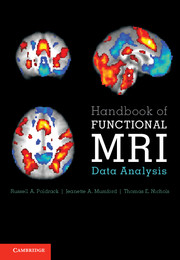Book contents
- Frontmatter
- Contents
- Preface
- 1 Introduction
- 2 Image processing basics
- 3 Preprocessing fMRI data
- 4 Spatial normalization
- 5 Statistical modeling: Single subject analysis
- 6 Statistical modeling: Group analysis
- 7 Statistical inference on images
- 8 Modeling brain connectivity
- 9 Multivoxel pattern analysis and machine learning
- 10 Visualizing, localizing, and reporting fMRI data
- Appendix A A Review of the General Linear Model
- Appendix B Data organization and management
- Appendix C Image formats
- Bibliography
- Index
5 - Statistical modeling: Single subject analysis
Published online by Cambridge University Press: 01 June 2011
- Frontmatter
- Contents
- Preface
- 1 Introduction
- 2 Image processing basics
- 3 Preprocessing fMRI data
- 4 Spatial normalization
- 5 Statistical modeling: Single subject analysis
- 6 Statistical modeling: Group analysis
- 7 Statistical inference on images
- 8 Modeling brain connectivity
- 9 Multivoxel pattern analysis and machine learning
- 10 Visualizing, localizing, and reporting fMRI data
- Appendix A A Review of the General Linear Model
- Appendix B Data organization and management
- Appendix C Image formats
- Bibliography
- Index
Summary
The goal of an fMRI data analysis is to analyze each voxel's time series to see whether the BOLD signal changes in response to some manipulation. For example, if a stimulus was repeatedly presented to a subject in a blocked fashion, following the trend shown in the red line in the top panel of Figure 5.1, we would search for voxel time series that match this pattern, such as the BOLD signal shown in blue. The tool used to fit and detect this variation is the general linear model (GLM), where the BOLD time series plays the role of dependent variable, and the independent variables in the model reflect the expected BOLD stimulus timecourses. Observe, though, that square wave predictor in red doesn't follow the BOLD data very well, due to sluggish response of the physiology. This leads to one major focus of this chapter: Using our understanding of the BOLD response to create GLM predictors that will model the BOLD signal as accurately as possible. The other focus is modeling and accounting for BOLD noise and other souces of variation in fMRI time series.
Throughout this chapter the models being discussed will refer to modeling the BOLD signal in a single voxel in the brain. Such a voxel-by-voxel approach is known as a mass univariate data analysis, in contrast to a multivariate approach (see Chapters 8 and 9 for uses of multivariate models).
Information
- Type
- Chapter
- Information
- Handbook of Functional MRI Data Analysis , pp. 70 - 99Publisher: Cambridge University PressPrint publication year: 2011
Accessibility standard: Unknown
Why this information is here
This section outlines the accessibility features of this content - including support for screen readers, full keyboard navigation and high-contrast display options. This may not be relevant for you.Accessibility Information
- 3
- Cited by
